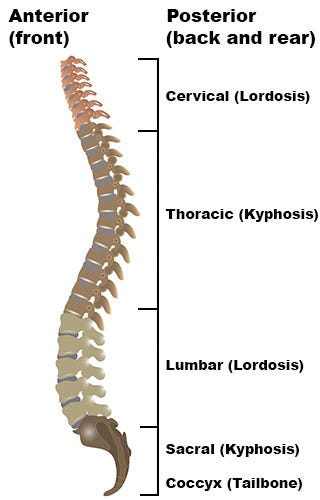Intro
Salam Fellaz. Last week we worked out how to diagnose a back issue through taking a history and performing provocative testing. This week we get into the bangers and mash of fixing the damn issue - which of course you have been waiting so diligently for. Let’s get into it.
Thpinal Hygiene
Spinal hygiene is not a rehab programme per se… Much like washing the dishes isn’t cooking, it is nonetheless a pre-requisite and essential component towards doing the actual “thing.”
But what is it? In short, as defined by Prof Mcgill - it is “removing the offending actions.” Or in normal-speak, eliminating the pain-causing movements. So if you are flexion-intolerant - don’t forward fold and don’t sit for prolonged periods.
This was a concept I completely turned on its head during my rehab. Deep in my dunce-like preparation for a competition - I was under the impression that I should immediately “work through the pain” following onset of the injury. This is a losing strategy.
First eliminate pain-provoking movements, let the spine chill for a bit - then build back up.
But first, let’s walk it back a couple of steps. How does one define “spinal hygiene.”
The answer comes in two phrases I want you to remember for time immemorial:
Neutral Spine
Hip Hinge.
The Neutral Spine
The neutral spine is defined by an S shape - with the three portions of the spine (cervical, thoracic and lumbar) forming different parts of the S.
Both the Cervical and Lumbar spine are typically inwardly curving (lordosis) and the thoracic spine (sandwiched between the two) is outwardly curving (kyphosis).
In short, in order to “spare” your spine - you should work with its natural curvature - rather than against it.
Maintaining a neutral spine, as hinted previously is as simple as two words - “hip” and “hinge.”
Hip Hinge
The hip hinge is the foremost essential movement pattern for sparing your spine on a day-to-day: in the gaff, at Lidl, when brushing teeth, at work and whilst handling your grandmother’s groceries.
For those who lift or are interested in fitness the hip hinge is seen in a bunch of classic movements - the deadlift, the Romanian deadlift, the good morning, the straddle pose and the kettle bell swing.
However, for sufferers of the grandfather back - spinal hygiene isn’t as simple as RDL’ing your way to spinal nirvana.
Indeed, for the more sensitive spines; we first must look to utilise the least intensive of the hip-hinge movements - the so-called short-stop squat.
The short-stop squat is performed as follows (see below video for a demonstration also):
Stand shoulder width apart and brace the core
place your hands on your thighs
reach backwards with your hips - as if you’re trying to reach a toilet seat with your ass. Maintain a neutral spine whilst doing so.
Whilst doing step 3 - slide your hands down your knees and continue bracing your core.
Ensure your shoulders are pinned back during the movement - in a so-called “anti-shrug” posture - push your chest forward and retract your scapula downwards and backwards.
Pick up the food-waste bin from the floor.
Push through your hips, maintaining a neutral spine throughout bringing your hips through until you are fully upright again.
https://youtube.com/shorts/4_GTzX1-KEI?si=Yo32pC9z1O_A5XSV
Once proficiency in the short-stop squat is achieved and your back becomes less touchy - feel free to hinge without the support of your arms.
For very low (and light) objects - play golf
Even with perfect form, it is ill-advised for the back pain sufferer to hip hinge all the way down to the floor. Instead, perform a “golfer’s lift” - it’s a hip hinge on one leg: extend your rear leg backwards - using it as a counterweight to the hip hinge. As always, brace your core, keep shoulders retracted and push through your hips to come back up.
A note on sitting
Sitting is the new smoking, so they say. But it doesn’t always need to be. Particularly if you preserve the natural curves of the spine detailed above. Sit upright, keep your shoulders pinned back, keep the neck straight and a neutral spine should be maintained.
However, sitting is no doubt a losing battle. Inevitably, after 2 football games worth of gawking at excel and being vegetated by the office LEDs - chinks in the armour begin to emerge… You start slouching, hunching and assuming the exact posture of a king prawn.
Further, (paradoxically) flexion-intolerant individuals tend to sit with their spine flexed. So, despite your best efforts - if you’re flexion intolerant you need to avoid sitting for sustained periods.
For this problem, there are a few simple solutions. The first is the height-adjustable desk - whack that baby at elbow-height and write the next brothers karamazov.
However, for those who don’t have access to the elite of spine-sparing ergonomics, there are a few more rustic options.
Just get up and walk blud. Get a tea, say hello, put the chicken in the oven - any excuse just get up and do a quick lap.
Finally we have a bit of McGill magic to reverse the prawning effect of sustained sitting. Get up, reach your hands to the heavens, count to ten, now reach back even further opening up your palms to the top floor. Let your spine gradually arch into extension, then drop your arms back down to your sides and relax. Ahhhhh.
A note on walking
As we’ll cover in later episodes walking is your back’s masseuse - a soothing tonic, a warm balm, a reverse boa-constrictor, but for now - let’s cover the more hygienic aspects.
The key to sparing your spine whilst walking lies in the speed of walking and what you’re doing with your arms.
In short - walk relatively quickly and swing your f*cking arms. If you walk like a grandmother - you really cannot expect any improvement in your geriatric spine.
Focus on maintaining a neutral spine - head straight, shoulders back and swing your arms like a proud army general.
Walk at a relatively brisk pace also - this will alleviate static loading of the spine and start the process of loosening your back.
For a good example - watch how Dr Mcgill walks in this Youtube short.
A note on sneezing - sneeze upwards
Sneezing is the grim reaper of all spinal sufferers. That most violent of human reflexes - head bucking, spine whiplashing, body convulsing and the worst bit - you don’t know if the spine’ll make it.
For this there is a simple solution. Once you feel the reaper about to make a visit - look to the heavens, arch your back slightly, point your snotbox at the sun and sneeze “up.” It might not be all pleasant, but you can be damned sure you won’t jolt into flexion and shrivel up like a crisp.
Getting into the Ferrari
Two legs at a time.
Never has my spine been more jarred than after stepping into Daddy’s Lambo one leg at a time. The seating was dreadfully low and well… I simply couldn’t slip into the passy without crunching up like a pretzel, it was so intense honestly.
In all seriousness… The key to getting into cars in a spine-sparing fashion is to cover the “descent” with the good ol’ hip hinge. Open the door, give yourself plenty of space, hip hinge down to the car seat then swing both legs inside - bosh.



